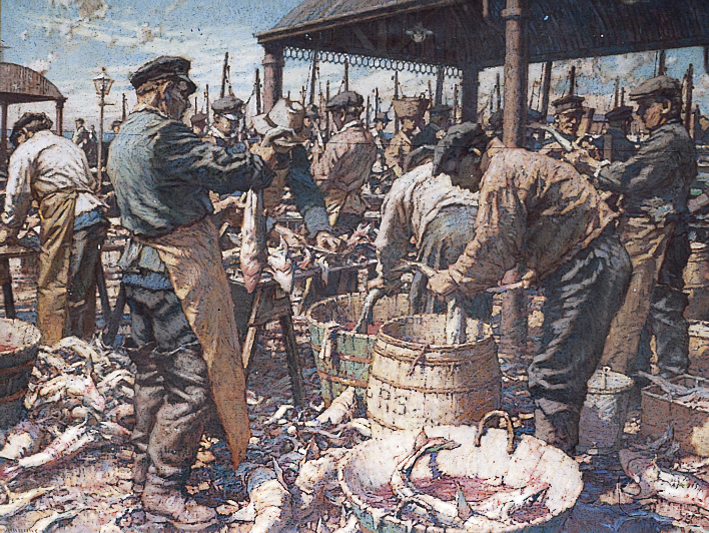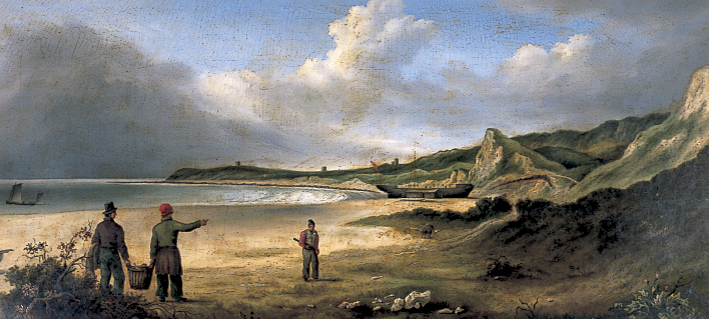About
The History of the Museum
The origins of Folkestone Museum are tied to the fortunes of the antiquarian and fossil enthusiast Mr. Samuel Joseph Mackie. His financial troubles in 1856 were personally disastrous but they started a series of events which resulted in the formation of the first temporary museum in Folkestone. As part of the liquidation of his assets, his large collection of fossils was put up for auction on 18 February 1857 and sold to a group of local tradesmen for £33. They subsequently passed their interest to J. G. Breach, the proprietor of the Pavilion Hotel, who in turn gifted the collection to the Town Council with a request that it should be accessible and form the foundation of a town museum. Eventually a room was hired from Mr. Dunk in Tontine Street for one year to be used as a temporary museum.
Natural History formed the core of the original museum collection and remains an important part of the collection today, with wonderful specimens of butterflies, shells and fossils of national and international significance. In the early days of the museum, a Natural History Society was formed in 1868 with Henry Ullyett as the society’s principal proponent. One of the main aims of the society was to establish a proper museum in more suitable premises.
Finally in 1888 the library, reading room and museum was established at Grace Hill and the museum collections were duly transferred into the care of the Folkestone Borough Council in May 1888 and moved to the new building. Mackie’s collection of local fossils formed the basis of the Folkestone collection, which has since expanded to reflect the historical development of the town through archaeology, social history and fine art. In the early 1900s the Dover Hill Anglo-Saxon burial ground was discovered during works to build a new coastal road and several skeletons were exhumed along with grave goods and added to the museum collections. 1920s excavations on the East Cliff of the Roman villa site further enhanced the museum’s archeological collections. Throughout the 20th century, as Folkestone developed, further signs of early habitation, dating as far back as the Bronze Age, were discovered at sites such as the Cheriton Urnfield and the archeaological remains were transferred to the museum. Local inhabitants donated items of social history such as costume and further fossil and archeological finds and in 1924 Amy Master donated an important folio of works on paper including Italian and Spanish Old Master drawings and original engravings by Albrecht Dürer. Post WWII, care of the collections was ad-hoc: the last full-time curator retired in the 1940s and the Borough Librarian became the Curator until the reorganization of local government in 1974 when Shepway District Council was created. There was a brief hiatus in management until Kent County Museum service took over and reorganized all of the museum collection. Much of the collection went into long term storage in the Folkestone library and to various sites in Maidstone.
In 2007 the museum was officially de-registered from the Museums, Libraries and Archives. The de-registering reflected Kent County Council’s earlier decision to end the museum and to develop a history resource service at Folkestone Library based on integrating elements of the collection within the local studies library service. In response to this, the Folkestone Heritage Working Group was established by Folkestone Town Council with the main focus of working towards the creation of a new Folkestone Museum. The group was made up of academics, local historians, councillors and officers who met on a regular basis to drive forward the ambition of a museum. From 2010 to 2012, the Heritage Lottery Fund and the European Regional Development Fund (Interreg) funded the ‘Treasures Revealed’ project to make the heritage collections accessible. the funding was used to create a visible store, conserve paintings, install interactives and run workshops. This project emphasised the public’s appetite for a proper museum to provide ongoing access to the collections.
In June 2011 Folkestone Town Council purchased the Town Hall. Consultants were then appointed to undertake a feasibility study to evaluate the viability of using the Town Hall as a Museum. This included a market assessment, public consultation, the development of a vision for a new museum, suggested governance structure and recommendations for use of the Town Hall spaces and likely running costs. The findings from the feasibility study were submitted to the Heritage Lottery Fund and evidenced that the Town Hall provided the Town Council with a suitable space to achieve their aspirations for the new museum. In April 2013 Kent County Council officially agreed to gift the old Folkestone Museum collection to the Town Council.
From spring 2017 the museum opens its doors to the public to provide a gateway to Folkestone’s fascinating heritage with interactive displays, workshops suitable for all ages and opportunities for people to become more involved with the presentation and preservation of the Town’s past.
A History of the Town Hall
In the 1830s early Folkestone council sessions were held in a converted building known as ‘Cistern House’, which had been leased from Lord Radnor and stood on the site of the present building. It continued to be used until 1858 when it was demolished as it was too small and simply not in keeping with an up and coming seaside resort. The council then used the Apollonian Hall (in the High Street) which was owned by the Wesleyans and also used as their Chapel. This was then converted into a Police Station and Sessions Hall.
The problem of not having a purpose built public building was brought to a head in 1855 when Charles Dickens visited only to find that there was no suitable place for a reading of A Christmas Carol. As a result, in November 1858, the Mayor proposed a competition with a premium of £50 for the design for a new Town Hall. In February 1859 Joseph Messenger was chosen as the successful architect and was instructed to obtain tenders for his building. By the 2nd March 1859 six tenders were received and the lowest, that of John Edwards, was accepted. In brick the cost was £2950 and in Portland stone £3245. Indeed, the Town Hall is the only building in Folkestone to be constructed with Portland Stone, reflecting the rising fortunes and stature of the town in the Victorian period.
On the 17th May 1859 at 3pm the foundation stone was laid. Under the stone, a glass bottle was placed containing a scroll commemorating the ceremony, signed by all the members of the council and sealed with the corporation seal.
On the 17th September 1859, a Mr Shaw reported various issues with the construction: that the covered market was being built over a drain, which ‘Mr Messenger should have been aware of’ and that the foundations, piers and roof joists were inadequate. A rumpus pursued and by 16th November 1859 Joseph messenger resigned. In 1860 new architects, Messrs Whichford and Blandford of Maidstone were employed and the building’s defects redesigned and rectified.
The grand building was to have three floors and a gallery. It was to contain the Town Hall and market place on the ground floor, a magistrate’s room, town sergeant’s room, a parade room, a police office and five cells – all in the basement with its own entrance. The first floor was to contain the entertainments hall with a gallery and an elaborate foul air extractor system.
On the 18th May 1861 the new Town Hall opened. The cost was £8683 – exceeding the original estimate. That evening a grand concert took place under the patronage of the Mayor and corporation with an array of artists amongst whom were soprano Miss Fanny Rowland, solo Violinist Mr H W Hill (Of the Royal Italian Opera) and contralto Miss Pitt (of the Royal Academy).
By 1861, despite a few teething problems, the Town Hall proved to be a great benefit to the people of Folkestone and on the 15th October 1861, Baron Meyer de Rothschild gifted the borough the illuminated clock on the front of the building. In 1879 the porch that is visible today was added to the front façade.
The Town Hall minutes are surprisingly sparse for such an up and coming popular seaside resort during the Edwardian era but the following are taken from the remaining archives. The Town Council did not acknowledge the commencement of what would become known as The Great War (WWI) until the 2nd September 1914. The Town Hall Minutes record; The Mayor and members were, “Under the shadow of a great cloud” and that, “They could not tell what the result might be, but it was their duty as patriotic citizens and as members of the council, to do what they possibly could to keep people from getting panic-stricken.” He appealed to them “to exercise all the possible forbearance they could to help in any measure necessary for the protection, safety and welfare of the country.”
The Town Hall minutes are surprisingly sparse for such an up and coming popular seaside resort during the Edwardian era but the following are taken from the remaining archives. The Town Council did not acknowledge the commencement of what would become known as The Great War (WWI) until the 2nd September 1914. The Town Hall Minutes record; The Mayor and members were, “Under the shadow of a great cloud” and that, “They could not tell what the result might be, but it was their duty as patriotic citizens and as members of the council, to do what they possibly could to keep people from getting panic-stricken.” He appealed to them “to exercise all the possible forbearance they could to help in any measure necessary for the protection, safety and welfare of the country.”
During WWII, the building was used as the Folkestone Report and Control Centre. Underneath the Town Hall, the response to air raids, bombings, shelling and other incidents were co-ordinated. The minutes from the period do not refer to individual incidents that occurred at the Town Hall.
In 1939 the Town Sergeant reported that material was required for darkening the windows at the Town Hall. The Town Hall passage was looked at by the borough engineer so that steps could be taken for the protection of the control room.
The following is an excerpt from an interview with Joan Holloway recorded by Rob Illingworth of the Folkestone Heritage Team on 27th August 2003. It is added to the site with her permission and is reproduced here by Rob Illingworth’s permission. Contributed by Kent Libraries- Shepway District, Article ID: A2204858 (Joan Holloway).
Joan Holloway served in the Folkestone Report and Control centre. In 1942 she joined the army and eventually became a cartographer working on the photographs taken by allied planes to create maps for the advancing troops. She remembers the mapping of Arnhem as a particularly demanding task. During this latter phase of her career she encountered Eisenhower with whom she was less than impressed!
“…..In the control room proper we had a map of the district. Our district finished at Seabrook at the old courthouse, (where the Little Chef is.)… [The map] showed every house, every garden shed. It was an ordnance map which filled that [points to 10” X 10” wall] because, to get to the top of it, Johnny Johnson had to stand on steps. As things happened you put pins in. You had your pins for your Rescue people and your First Aid people (though we were all trained in First Aid as well [along with] most of the Rescue people.) And the representatives of those, once the thing was sorted, they took over and handled all their side of things.
Our Controller was an ex-Indian Army character, Captain Keary, who was an absolute Poppit, and our second in command was Walter Bateman, the baritone, great fun. A happy bunch.” (Joan’s colleagues also included other members of the Folkestone Operatic Society and a former Miss Folkestone.) The Town hall continued as a municipal building throughout the war for the people of Folkestone and as the Police station and home to the court and Council.”
A few decades after its survival through WWII, the fortunes of the Town Hall dwindled. After the dissolution of the Folkestone Borough Council a series of proposals came for the Town Hall (between 1972 and 1982 the Town Hall remained empty) including: a casino; a community centre; a snooker hall; shopping arcade; a museum and history centre; or demolition to make way for a department store. In September 1979 the Town Hall briefly opened as an arts and crafts centre but closed due to non-payment of rates a year later. By December 1985 the Town Hall was put on the property market and a proposal for McDonalds was withdrawn. In May 1986 the Town Hall was auctioned in London and sold to Indian Pru Co ltd for £180,000. Indian Pru Co Ltd was granted permission by Shepway District Council to turn the Town Hall basement and ground floor into a wine bar / pub leisure hall, restore the building and make alterations. In March 1989 Superdrug opened on the ground floor and in 1990 Silverscreen cinema opened on the first floor. In 1998 Waterstone’s moved in to the ground floor and then briefly Madhouse clothing store from 2010-2011.
Folkestone Town Council bought back the Town Hall in June 2011 and following a successful dilapidations claim and essential capital works moved into the Town Hall in December 2012. A grant of 1.9 million from Heritage lottery Fund enabled Folkestone Town Council to restore the original council sessions chamber on the first floor of the building (now shared with Silverscreen cinema) and install the new Folkestone Museum on the first and basement floors, commencing a new and exciting chapter in the history of the Town Hall and repositioning the building once again at the heart of its thriving community.



